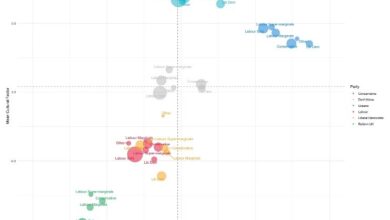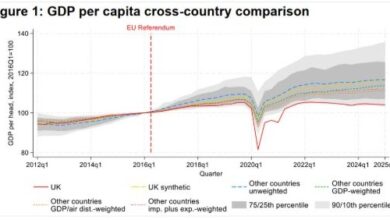
Rob
Ford, previewing the upcoming election on 1st May in
the Guardian, emphasises how the Liberal Democrats, Greens and Reform are likely to make
big gains. Going further, in a recent
article in Prospect, Peter Kellner suggests the domination of Labour and Conservatives, even in general elections where the First Past The Post (FPTP) voting system gives them a huge advantage, is over for good. I started out being more sceptical, but as I’m an amateur on
these matters, I thought it was worth discussing in more depth.
The key evidence in
favour of the view that multiparty politics in the UK [1] is here to
stay is the trend in vote shares since shortly after WWII. Here is a
more complete version of the numbers that Kellner gives in his
article.
Since 1951, the UK
vote share of Labour and the Conservatives combined has fallen from
nearly 90% to below 60% in 2024. However the last observation is
important. Kellner argues, convincingly in my view, that 2017 and
2019 are outliers because Brexit polarised politics, and so 2024
represents a return to a falling trend for the two main party’s
vote share. But is this really a trend or a series of step changes
due to clearly defined political developments?
Until 2010, the fall
in the Lab+Con share was largely about a rising share for the
Liberals/SDP-Liberal Alliance/Liberal Democrats, and here there is a
clear step change around the 1970s. From 1945 to 1970 the Liberal
vote share oscillated just below 10%, but from 1974 to 2010 it
averaged around 20%. The rise in nationalist parties in Scotland and
Wales plus the rise in UKIP in the 2000s (to achieve a 3% vote share
in 2010) has a more modest influence over this period. In 2015 the LibDem
vote collapsed, but the UKIP vote, and to a lesser extent the Green
party vote, rose to almost compensate. Even if we discount 2017 and
2019 as Kellner suggests, 2024 looks like another step change, with
the combined vote share of Reform, LibDems and the Greens being 33%.
The argument I want
to present is that these two step changes occurred when the two major
parties moved away from being close to where the average voter is. To understand more recent movements, we need to look at policy space
in two rather than one dimension.
In the diagram above, the centre is where the average voter is, which may change over time as voter opinion changes. From 1945 to 1970,
both parties were close to the centre of electoral opinion, with
Labour being a little more left wing and socially liberal, the
Conservatives more right wing and socially conservative. [2] Most of
the political action was about economics, and voting was largely class based. FPTP ensured that there was little scope for
other parties to gain a substantial vote share.
The 1970s brought
inflation and industrial unrest, and I would suggest as a result
public opinion moved away from both the union movement and a Labour
party using incomes policies to reduce inflation. In terms of the
diagram above, Labour shifted left because its policies didn’t
shift with public opinion. This produced a step increase in the
Liberal vote in 1974. The Conservatives in the 1970s (particularly
after Thatcher became leader) moved right in economic terms, a move
that in 1979 went well beyond public opinion and so they moved to the
right in the diagram above. The gap between Labour and the Tories in economic terms
was greatest in 1983, when the Labour vote share collapsed and the
SDP-Liberal Alliance won almost as big a vote share as Labour. After
1983 Labour gradually moved back towards the economic centre ground,
and won power again in 1997.
At this point the
Conservatives were now much further away from the centre ground than
Labour on economic issues, and as a result they began to campaign
much more on social issues, and immigration in particular. Voting
became less class based, and more age based (because older voters
tend to be more socially conservative). This may have allowed the
Conservatives to make inroads into traditionally Labour working class
areas, but initially at least economic interests meant that their
socially conservative rhetoric was not matched by actions. This led
to the emergence of a populist right wing party, UKIP, that started
to gain a significant vote share.
Skip to 2024, and
Labour moved to adopt some moderately socially conservative policy positions, and
also implicitly a more right wing policy in terms of public service provision. The Conservatives, in an attempt to counter the threat from
Farage, adopted even tougher socially conservative policies
(principally Brexit) and became increasingly populist in nature. This
had two effects. The first, relatively minor, was to give the Green
party its highest national vote share at 6.4%. The second, and
perhaps more important, was to give the socially liberal LibDems their highest seat total since WWII.
For power, under
FPTP, seats count for everything and vote share nothing. If the
Conservatives stay as they are, which is a populist party advocating
pretty extreme socially conservative views from a populist
perspective, this leaves socially liberal but economically right wing
voters very reluctant to vote for them. The Liberal Democrats in 2024
succeeded in capturing many of these votes, and as a result they
obtained their highest seat total since WWII with a much lower vote
share than most of the 1974-2010 period.
Seen in this way,
the 2024 General Election was not the latest point on some inevitable
trend to multi-party politics, but the result of shifts in the policy
stance of the two main parties. Essentially the Conservatives first
moved to neoliberalism, and then to right wing populism, and now
Labour has moved in that direction leaving a large part of policy
space empty for other parties to fill. As a consequence, whether this
situation persists or becomes more marked will depend on whether the
two main parties stay where they currently are, or whether they move
back to where they once were.
If the Conservatives
continue to focus on competing with Farage, then the LibDems have a
good chance of keeping their high seat total, but their scope for
further growth is modest as they were
last year second in only 27 seats. [4] Otherwise the main
beneficiary of this Reform/Tory battle is Labour. If Labour stay
where they currently are, the Green party is second to Labour in 39
seats and therefore has scope to increase both its vote and seat
total. [3] If Farage can be persuaded into an electoral pact or (less
likely) the Conservatives collapse, we could get the neat result that
the UK becomes a four party system, with each party representing one of the quadrants in the diagram above.
However it is
equally possible that 2024 represents a low point for the two main
parties. Labour could, if only for purely electoral reasons, shift
back towards a moderately socially liberal position while at the same
time increasing taxes further to fund better public services, as they did in
the early 2000s. The Conservatives, under a new leader, could focus
more on winning back the Liberal Democrat rather than Reform vote. In
those circumstances Labour could use the prospect of a return of a
Tory government to squeeze the Green vote, with the Conservatives
using the same tactics to squeeze both the LibDems and Reform.
Both scenarios are
possible. In particular, with less tactical voting in Council
elections and more protest voting, the pressure on the two main
political parties to change their policy positions and tactics before
the next General Election will be intense. What is clear, if this
analysis is right, is that any continuing decline or resurgence in
the fortunes of the two main parties lies largely in their own hands.
[1] Multi-party
politics has of course been with us for some time in Scotland, Wales
and Northern Ireland, so this is really a question about England.
[2] In this diagram
the centre is the average of voter opinion, which in terms of policy
positions may shift over time. For example, since WWII voters have
been becoming much more socially liberal. Undoubtedly opinion did
shift left in 1945, which was why Labour’s radical policy agenda
was able to win that election, and Conservative policy did then shift
left to reflect that.
[3] Competition from
existing or new left wing parties would of course hinder this.
[4] The main danger for the LibDems is if Labour become very unpopular among economically right wing voters, and the Conservatives successfully argue that the LibDems would support a minority Labour government.
Source link






